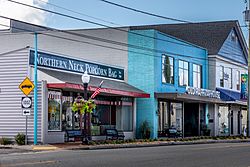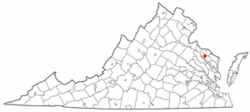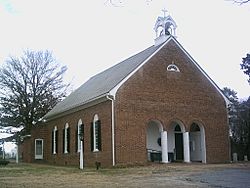Warsaw, Virginia facts for kids
Quick facts for kids
Warsaw
|
|
|---|---|

Downtown Warsaw 2020
|
|

Location of Warsaw, Virginia
|
|
| Country | United States |
| State | Virginia |
| County | Richmond |
| Government | |
| • Type | Council - Manager |
| Area | |
| • Total | 3.05 sq mi (7.91 km2) |
| • Land | 3.05 sq mi (7.91 km2) |
| • Water | 0.00 sq mi (0.00 km2) |
| Elevation | 131 ft (40 m) |
| Population
(2020)
|
|
| • Total | 1,637 |
| • Estimate
(2023)
|
2,330 |
| • Density | 545.66/sq mi (206.95/km2) |
| Time zone | UTC−5 (Eastern (EST)) |
| • Summer (DST) | UTC−4 (EDT) |
| ZIP code |
22572
|
| Area code | 804 |
| FIPS code | 51-83168 |
| GNIS ID | 1500279 |
Warsaw is a town in Richmond County, Virginia, United States. It is also the county seat, which means it's where the main government offices for the county are located. In 2020, about 1,637 people lived here. By 2023, the population was estimated to be around 2,330.
Contents
History of Warsaw
Before English settlers arrived, the area where Warsaw is now was home to the Rappahannock people. These Native Americans fished in the nearby creeks for shad and herring. By 1667, they had to sell their land north of the Rappahannock River to the English. This included the land where Warsaw stands today.
Founding and Early Years
In 1692, Old Rappahannock County was divided, and Richmond County was formed. The county's main town, called Richmond Court House, was first located by the Rappahannock River. In 1730, the town moved inland to its current spot, which is now Warsaw. A new court house was built there in 1748.
A famous person from this area was Robert Wormeley Carter. He lived near Richmond Court House at a historic home called Sabine Hall. He supported the American Revolution and represented Richmond County in important meetings like the House of Burgesses and the Continental Congress.
During the War of 1812, British soldiers attacked the region. Many local men gathered to defend their town. At this time, the town's economy grew because of tobacco farming. Wealthy farmers used the labor of indentured settlers and enslaved Africans to grow this crop.
How Warsaw Got Its Name
In January 1832, the town's name was changed to Warsaw. This happened after people heard about big uprisings in the city of Warsaw in Poland in 1830 and 1831. Many people in the town supported the Polish November Uprising. Other small towns in the United States, like Warsaw, Kentucky, also changed their names to Warsaw around the same time.
After the Civil War
After the Civil War, formerly enslaved people, known as freedmen, worked hard to create their own churches and schools. Over time, schools and churches in the region became officially desegregated. This happened after the Civil Rights Act was passed. However, it took until the 1970s for all schools in the area to be fully integrated.
Today, Warsaw is one of many small towns in Virginia's Northern Neck region. The town is proud of its schools, beautiful nature, and good quality of life for its residents.
Geography and Climate
Warsaw is located at 37°57′27″N 76°45′30″W / 37.95750°N 76.75833°W. The town covers an area of about 3.0 square miles (7.9 square kilometers), and all of it is land.
Warsaw's Climate
The weather in Warsaw has hot, humid summers. Winters are usually mild to cool. Warsaw has a humid subtropical climate. This means it gets a good amount of rain throughout the year, and it doesn't usually have very cold winters.
| Climate data for Warsaw, Virginia (1991–2020 normals, extremes 1893–present) | |||||||||||||
|---|---|---|---|---|---|---|---|---|---|---|---|---|---|
| Month | Jan | Feb | Mar | Apr | May | Jun | Jul | Aug | Sep | Oct | Nov | Dec | Year |
| Record high °F (°C) | 82 (28) |
81 (27) |
94 (34) |
97 (36) |
99 (37) |
105 (41) |
106 (41) |
103 (39) |
105 (41) |
100 (38) |
85 (29) |
82 (28) |
106 (41) |
| Mean daily maximum °F (°C) | 46.8 (8.2) |
50.4 (10.2) |
58.5 (14.7) |
69.7 (20.9) |
77.1 (25.1) |
84.3 (29.1) |
88.4 (31.3) |
86.4 (30.2) |
80.4 (26.9) |
70.4 (21.3) |
59.5 (15.3) |
50.0 (10.0) |
68.5 (20.3) |
| Daily mean °F (°C) | 37.6 (3.1) |
40.3 (4.6) |
47.5 (8.6) |
57.8 (14.3) |
66.2 (19.0) |
73.9 (23.3) |
78.2 (25.7) |
76.2 (24.6) |
70.1 (21.2) |
59.5 (15.3) |
49.3 (9.6) |
41.2 (5.1) |
58.1 (14.5) |
| Mean daily minimum °F (°C) | 28.5 (−1.9) |
30.2 (−1.0) |
36.5 (2.5) |
45.8 (7.7) |
55.3 (12.9) |
63.5 (17.5) |
68.1 (20.1) |
66.1 (18.9) |
59.8 (15.4) |
48.6 (9.2) |
39.1 (3.9) |
32.3 (0.2) |
47.8 (8.8) |
| Record low °F (°C) | −6 (−21) |
−5 (−21) |
5 (−15) |
14 (−10) |
29 (−2) |
38 (3) |
47 (8) |
44 (7) |
30 (−1) |
24 (−4) |
13 (−11) |
−3 (−19) |
−6 (−21) |
| Average precipitation inches (mm) | 3.02 (77) |
2.60 (66) |
3.66 (93) |
3.18 (81) |
3.90 (99) |
4.37 (111) |
4.73 (120) |
5.01 (127) |
4.15 (105) |
3.98 (101) |
3.29 (84) |
3.30 (84) |
45.19 (1,148) |
| Average snowfall inches (cm) | 4.4 (11) |
3.3 (8.4) |
1.4 (3.6) |
0.1 (0.25) |
0.0 (0.0) |
0.0 (0.0) |
0.0 (0.0) |
0.0 (0.0) |
0.0 (0.0) |
0.0 (0.0) |
0.1 (0.25) |
2.2 (5.6) |
11.5 (29) |
| Average precipitation days (≥ 0.01 in) | 8.9 | 8.1 | 9.3 | 10.4 | 11.3 | 11.0 | 10.4 | 9.6 | 9.0 | 9.3 | 8.4 | 9.1 | 114.8 |
| Average snowy days (≥ 0.1 in) | 1.6 | 1.5 | 0.6 | 0.0 | 0.0 | 0.0 | 0.0 | 0.0 | 0.0 | 0.0 | 0.0 | 0.9 | 4.6 |
| Source: NOAA | |||||||||||||
People of Warsaw
Here's a look at the different groups of people who lived in Warsaw in 2020:
| Race / Ethnicity | Pop 2020 | % 2020 |
|---|---|---|
| White alone (NH) | 1033 | 74.21% |
| Black or African American alone (NH) | 479 | 17.37% |
| Native American or Alaska Native alone (NH) | 1 | 0.26% |
| Asian alone (NH) | 10 | 1.32% |
| Pacific Islander alone (NH) | 0 | 0.00% |
| Some Other Race alone (NH) | 1 | 0.00% |
| Mixed Race/Multi-Racial (NH) | 44 | 3.42% |
| Hispanic or Latino (any race) | 69 | 3.42% |
| Total | 1,637 | 100.00% |
Note: The US Census counts Hispanic/Latino people as an ethnic group. This table shows them separately from the racial groups. Hispanic/Latino people can be of any race.
| Historical population | |||
|---|---|---|---|
| Census | Pop. | %± | |
| 1880 | 115 | — | |
| 1950 | 435 | — | |
| 1960 | 549 | 26.2% | |
| 1970 | 511 | −6.9% | |
| 1980 | 771 | 50.9% | |
| 1990 | 961 | 24.6% | |
| 2000 | 1,375 | 43.1% | |
| 2010 | 1,512 | 10.0% | |
| 2020 | 1,637 | 8.3% | |
| 2022 (est.) | 2,281 | 50.9% | |
| U.S. Decennial Census | |||
In 2000, there were 1,375 people living in Warsaw. About 13.3% of the population was under 18 years old. The median age was 44 years. This means half the people were younger than 44, and half were older.
Economy and Jobs
Warsaw is a central place for jobs and services in Richmond County. In 2017, a large part of the jobs in town (40%) were in education, health, and social services.
Education in Warsaw
The town has schools for all ages, including an elementary school, a middle school, and a high school. There is also a technical school and a campus of the Rappahannock Community College. This provides many learning opportunities for students.
Other Important Employers
Warsaw is also home to the Northern Neck Regional Jail. This facility was finished in 1995 and employs about 100 people. It can hold up to 460 individuals.
Tourism and History
Warsaw uses its rich history to attract visitors. There are several historic places nearby that people can visit:
- Menokin: The former home of Francis Lightfoot Lee, who signed the Declaration of Independence.
- Mount Airy and Sabine Hall: These are historic estates.
- Belle Mount: A former plantation that is now a vineyard and winery.
Other historic sites listed on the National Register of Historic Places include Grove Mount and the Richmond County Courthouse.
Notable People
Many interesting people have connections to Warsaw:
- Cal Bowdler – A power forward who played for the NBA's Atlanta Hawks.
- Robert Wormeley Carter – A member of the Virginia House of Burgesses and the Continental Congress.
- Jim Coates – A professional baseball pitcher who played for several Major League Baseball teams.
- William Atkinson Jones – A member of the United States House of Representatives who supported Philippine Independence.
- W. Tayloe Murphy (1901–1961) – A state delegate and state senator.
- Tom Robbins – An author who wrote about his childhood in Warsaw in his autobiography Tibetan Peach Pie.
See also
 In Spanish: Warsaw (Virginia) para niños
In Spanish: Warsaw (Virginia) para niños


